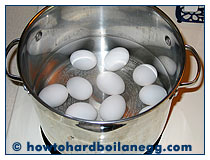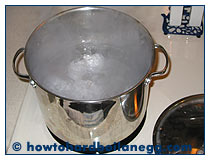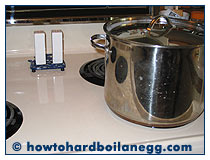|
Now cover your pot with a tight fitting lid,
set your pot on the stove and turn the burner to high. Plan
for approximately 6 minutes to bring the pot to boiling.
If your stove burners are especially hot or
if you have a gas stove, you may want to keep the temperature
just a notch from the highest setting so that the eggs don't
jostle around unnecessarily while the water heats up. Everytime
your eggs collide with each other it increases the likelihood
of one cracking. Also, if the water very rapidly comes to
a boil, the sudden change of temperature from cold to hot
puts additional stress on the shells and can result in eggs
splitting open during boiling.
 If
an egg cracks, it will likely happen when the egg is partially
cooked so you can simply leave the egg in the water until
you are ready to remove the rest from the pot after cooking.
(Depending on the severity of the crack, you can choose to
use the egg or discard. I would discard if the egg has lost
a significant portion of the white.) If
an egg cracks, it will likely happen when the egg is partially
cooked so you can simply leave the egg in the water until
you are ready to remove the rest from the pot after cooking.
(Depending on the severity of the crack, you can choose to
use the egg or discard. I would discard if the egg has lost
a significant portion of the white.)
Lift the lid and check progress often as the
water is heating - don't leave the kitchen at this point,
or leave the pot unattended, for safety reasons.
You need to let the water come to a full boil,
then take the pot off of the burner and move it to a cold
burner. (Don't forget to turn the hot burner off!)  Why
do we do this? If you allow the eggs to cook in boiling water
for several minutes, the egg white will toughen and become
rubbery. Egg white solidifies between 140ºF and 149ºF,
and the egg yolk will coagulate between 149ºF and 157ºF.
This temperature is much lower than the boiling point of water
(212ºF). Therefore, you don't need to boil the water
hard for an extended duration to cook your eggs. Why
do we do this? If you allow the eggs to cook in boiling water
for several minutes, the egg white will toughen and become
rubbery. Egg white solidifies between 140ºF and 149ºF,
and the egg yolk will coagulate between 149ºF and 157ºF.
This temperature is much lower than the boiling point of water
(212ºF). Therefore, you don't need to boil the water
hard for an extended duration to cook your eggs.
See the picture
to your right? As soon as you get large bubbles and steam,
take the pot off of the burner and move it to over to a burner
that's turned off. Be cautious and use oven gloves since the
pot will be hot.
After you have moved the pot, add 1 teaspoon
of vinegar over the water and eggs. (This will help make your
eggs easier to peel.) No stirring is necessary. The peeled
eggs will not taste vinegar-y, by the way, so no worries there.
 Here
in this picture, I have taken the pot off of the burner used
for cooking, moved it over to a cold burner, covered the pot
back up, and am letting the eggs sit in the hot water for
30 minutes to finish cooking. You may wish to set the timer
on your stove to remind you to come back for the next step
or you may end up doing what I have done on occasion - forgotten
about the pot for a couple of hours while I got busy with
a phone call or chores. If you do end up leaving the eggs
for too long in the hot water, the eggs will tougher and the
yolks likely lighter but they are still edible, and you can
still move on to peeling them. If you have left the eggs longer
than an hour, I would get them peeled and in the refrigerator as soon as possible. Eggs left at room
temperature can spoil quickly, especially during the summer months. Here
in this picture, I have taken the pot off of the burner used
for cooking, moved it over to a cold burner, covered the pot
back up, and am letting the eggs sit in the hot water for
30 minutes to finish cooking. You may wish to set the timer
on your stove to remind you to come back for the next step
or you may end up doing what I have done on occasion - forgotten
about the pot for a couple of hours while I got busy with
a phone call or chores. If you do end up leaving the eggs
for too long in the hot water, the eggs will tougher and the
yolks likely lighter but they are still edible, and you can
still move on to peeling them. If you have left the eggs longer
than an hour, I would get them peeled and in the refrigerator as soon as possible. Eggs left at room
temperature can spoil quickly, especially during the summer months.
On to cooling and
peeling! ...
|


 If
an egg cracks, it will likely happen when the egg is partially
cooked so you can simply leave the egg in the water until
you are ready to remove the rest from the pot after cooking.
(Depending on the severity of the crack, you can choose to
use the egg or discard. I would discard if the egg has lost
a significant portion of the white.)
If
an egg cracks, it will likely happen when the egg is partially
cooked so you can simply leave the egg in the water until
you are ready to remove the rest from the pot after cooking.
(Depending on the severity of the crack, you can choose to
use the egg or discard. I would discard if the egg has lost
a significant portion of the white.)  Why
do we do this? If you allow the eggs to cook in boiling water
for several minutes, the egg white will toughen and become
rubbery. Egg white solidifies between 140ºF and 149ºF,
and the egg yolk will coagulate between 149ºF and 157ºF.
This temperature is much lower than the boiling point of water
(212ºF). Therefore, you don't need to boil the water
hard for an extended duration to cook your eggs.
Why
do we do this? If you allow the eggs to cook in boiling water
for several minutes, the egg white will toughen and become
rubbery. Egg white solidifies between 140ºF and 149ºF,
and the egg yolk will coagulate between 149ºF and 157ºF.
This temperature is much lower than the boiling point of water
(212ºF). Therefore, you don't need to boil the water
hard for an extended duration to cook your eggs.  Here
in this picture, I have taken the pot off of the burner used
for cooking, moved it over to a cold burner, covered the pot
back up, and am letting the eggs sit in the hot water for
30 minutes to finish cooking. You may wish to set the timer
on your stove to remind you to come back for the next step
or you may end up doing what I have done on occasion - forgotten
about the pot for a couple of hours while I got busy with
a phone call or chores. If you do end up leaving the eggs
for too long in the hot water, the eggs will tougher and the
yolks likely lighter but they are still edible, and you can
still move on to peeling them. If you have left the eggs longer
than an hour, I would get them peeled and in the refrigerator as soon as possible. Eggs left at room
temperature can spoil quickly, especially during the summer months.
Here
in this picture, I have taken the pot off of the burner used
for cooking, moved it over to a cold burner, covered the pot
back up, and am letting the eggs sit in the hot water for
30 minutes to finish cooking. You may wish to set the timer
on your stove to remind you to come back for the next step
or you may end up doing what I have done on occasion - forgotten
about the pot for a couple of hours while I got busy with
a phone call or chores. If you do end up leaving the eggs
for too long in the hot water, the eggs will tougher and the
yolks likely lighter but they are still edible, and you can
still move on to peeling them. If you have left the eggs longer
than an hour, I would get them peeled and in the refrigerator as soon as possible. Eggs left at room
temperature can spoil quickly, especially during the summer months.